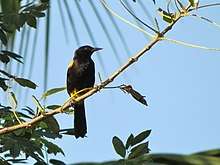Puerto Rican oriole
The Puerto Rican oriole (Icterus portoricensis) is a species of bird in the family Icteridae, and genus Icterus or New World blackbirds. This species is a part of a subgroup of orioles (Clade A) that includes the North American orchard oriole, Icterus spurius, and the hooded oriole, Icterus cucullatus.
| Puerto Rican oriole | |
|---|---|
 | |
| Scientific classification | |
| Kingdom: | Animalia |
| Phylum: | Chordata |
| Class: | Aves |
| Order: | Passeriformes |
| Family: | Icteridae |
| Genus: | Icterus |
| Species: | I. portoricensis |
| Binomial name | |
| Icterus portoricensis (H. Bryant, 1866) | |
The Puerto Rican oriole was previously grouped with Cuban oriole (Icterus melanopsis), Hispaniolan oriole (Icterus dominicensis), and Bahama oriole (Icterus northropi) as a single species, (Icterus dominicensis). In 2010, all four species became recognized as full species by the American Ornithologists' Union.[2]
Habitat
The oriole is endemic to Puerto Rico. Its natural habitats are the tropical forests, mangrove forests, and plantations. The bird also shows a natural preference for nesting in palm trees.[3]
Behavior
After breeding, adult Puerto Rican orioles and their young will remain together in a family group. It primarily forages in dense vegetation looking for a wide range of foods that includes fruits, insects, lizards, and nuts and grains.[3]
Description
Males and females are similar in size and color. Males weigh about 41.0 grams and females weigh about 36.6 g. The average wingspan of males and females is 96.9 and 92.1 mm, respectively.[4] In 2008, Hofmann, Cronin, and Omland, conducted a study that showed there is little color difference in the feathers between the males and females of many tropical orioles, including the Puerto Rican oriole.[5] This means that males and females both have elaborate colors, in contrast many temperate-zoned birds have brightly colored males and dull colored females.
Adults are black with yellow on their lower belly and shoulder. The closely related Hispaniolan oriole (Icterus dominicensis) and Bahama oriole (Icterus northropi) have more yellow on their bodies, but, the Cuban oriole (Icterus melanopsis) has more black.[3]
Juveniles are tawny colored with an olive tint to their rump.[4] Puerto Rican orioles develop their bright colors as they age. The tawny color offers a selective advantage to the adolescents since by helping with camouflage in the dense forest. This is likely the ancestral state for the genus Icterus.
Communication
It is likely that both males and females of the Puerto Rican oriole sing. It is often assumed that only the males sing, since that is the case for many temperate-zone birds. However, in 2009, Price, Lanyon, and Omland conducted a study that shows that both males and females of many tropical orioles sing. It is likely that I. portoricensis behaves similarly.[6] The song of the Puerto Rican oriole is composed of clicks or “high pitched whistles” [4] and has a frequency range between 3.6 and 5.3 kHz. The bird combines between 15 and 27 different notes to make up their song.[7]
Reproduction
Most members of this genus are thought to be monogamous, establishing lifelong bonds between males and females. The Puerto Rican oriole breeds primarily from February through July. It lays about three eggs per clutch.[3] The eggs are white with a bluish hue with light lavender-gray-brown speckles and spots.[4] The nests of most species in this clade have loosely hanging nests, often suspended under palms trees.[3]
See also
- Fauna of Puerto Rico
- List of birds of Puerto Rico
- List of endemic fauna of Puerto Rico
- List of Puerto Rican birds
- List of Vieques birds
- El Toro Wilderness
References
- BirdLife International (2012). "Icterus portoricensis". IUCN Red List of Threatened Species. 2012. Retrieved 26 November 2013.CS1 maint: ref=harv (link)
- Chesser, R. T., R. C. Banks, F. K. Barker, C. Cicero, J. L. Dunn, A. W. Kratter, I. J. Lovette, P. C. Rasmussen, J. V. Remsen, Jr, J. D. Rising , D. F. Stotz, and K. Winker. 2010. Fifty-first supplement to the American Ornithologists’ Union Check-list of North American Birds. Auk 127(3):726-744.
- Jaramillo, A., P. Burke. 1999. New World Blackbirds. Princeton: Princeton University Press.
- Garrido, O., J. Wiley, A. Kirkconnell. 2005. Genus Icterus in the West Indies. Ornitologia Neotropical, 16: 449-470.
- Hofmann, C., T. Cronin, K. Omland. 2008. Evolution of sexual dichromatism. 1. convergent losses of elaborate female coloration in New World orioles (Icterus spp.).Auk, 125: 778-789.
- Price, J., S. Lanyon, K. Omland. 2009. Losses of female song with changes from tropical to temperate breeding in the New World blackbirds. Proceedings Royal Society of London, Biological Sciences, 276: 1971-1980.
- Price, J., N. Friedman, K. Omland. 2007. Song and plumage evolution in the New World orioles (Icterus) show similar lability and convergence in patterns. Evolution, 61: 850-863
]
